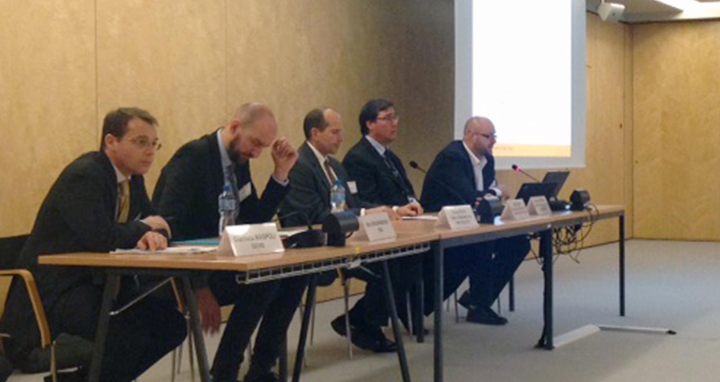
Between February 16th and 19th, the international mine action community gathered in Geneva for the 18th International Meeting of Mine Action National Program Directors and UN Advisors. This year’s theme was “Beyond Mine Action”. The TRWP and the GICHD hosted a side event on ‘Mine action, the environment and toxics remnants of war’. Its aim was to explore whether it is both feasible and desirable for the mine action community to go further in integrating environmental assessment for TRW in its activities.
By Michelle de Gruijl and Kristine te Pas
The TRWP’s Doug Weir began the event with an overview of the practices that generate TRW and the factors which influence the risks they pose to civilians and the environment. Besides heavy metals in munitions and bombings, the destruction of critical infrastructure and buildings and the targeting of industrial areas and chemical facilities may generate toxic hazards that pose risks to the environment and to civilian health. Government structures, such as environmental monitoring systems and hazardous waste collection, often diminish during conflict, increasing the likelihood of exposures that may harm civilians.
Wim Zwijnenburg (PAX) elaborated upon this by discussing a case study on the ongoing Syrian conflict, which is part of a desktop study that will be published this May. Data for the study has been collected through online resources, such as social media, YouTube videos, media and anecdotal reports. The report focuses on practices that generate TRW and on factors associated with the conflict that increase the likelihood of civilian exposure.
In the context of the Syrian conflict this includes toxic substances in munitions – with a particular focus on the wide range of DIY weapons in use, attacks on industrial sites and critical infrastructure, conflict rubble, and the looting of hazardous substances. When the Syrian conflict finally ends, this report may serve as a guideline for post-war assistance programmes. Yet it also became clear during the data collection that a more robust independent environmental monitoring system is needed during conflicts in order to be able to properly document TRW hazards.
The event then heard from two mine action organisations, one humanitarian, one commercial, that already go “beyond mine action” into assessing and mitigating the risks from TRW. Hansjörg Eberle (Swiss Foundation for Mine Action) spoke about mine action and legacy pollution issues that they have worked in Libya and Tajikistan. This included abandoned precursor materials for chemical weapons and uranium mine tailings from the Soviet nuclear programme.
The mine action community is potentially well placed to take up a role that goes beyond clearance activities for explosive remnants of war, as it has swift and direct access to the field and existing systems that could be modified to record data on environmental contaminants and damage. In addition, as commercial entities and defence research agencies have already established a wide range of methodologies on how to clean-up domestic firing ranges and military bases, their knowledge and expertise may be readily transferable.
This was discussed by Mark Albe (National Association of Ordnance Contractors), who spoke about environmental assessments of operational and former ranges and munition sites in the US. Because sites in the continental US come under domestic environmental law, the regulatory framework requires that a range of military-origin pollutants are considered during schemes, including munitions constituents.
Finally, Dr Gianluca Maspoli (GICHD) addressed the existing state of environmental assessment in mine action programmes, which relates primarily to the environmental impact of clearance operations themselves. GICHD has developed best practice guidelines through the IMAS system for efforts to ‘do no harm’ in operations.
Expanding the number of actors recording data on environmental damage and contamination from conflict is not only important from a civilian health perspective, it could also help give a clearer picture of both the impact of conflict itself and the acceptability of particular military practices. Being able to collect data earlier would also help to show changes in environmental quality over time and help identify locations for more comprehensive assessment at a later date.
Integrating the collection of data on TRW is an example of other efforts to mainstream environmental considerations in post-conflict response. Beyond the work of UNEP, the OCHA-UNEP Joint Environment Unit has a long running programme that seeks to mainstream the environment in humanitarian response, where the main focus to date has been on natural disasters. The WHO’s International Programme on Chemical Safety is also seeking to address the public health and environmental impact of chemical incidents and emergencies, focusing on the management and security of industrial chemicals, both of which can be negatively impacted by the outbreak of conflict.
NB – the female speaker we had approached for the panel was unable to join us, resulting in an unfortunate gender balance among the presenters, for which we apologise. For more information on the Male Panels Initiative see Article 36.
 PAX means peace. PAX brings together people who have the courage to stand for peace. Together with people in conflict areas and concerned citizens worldwide, PAX works to build just and peaceful societies across the globe. Read more about PAX on www.paxforpeace.nl.
PAX means peace. PAX brings together people who have the courage to stand for peace. Together with people in conflict areas and concerned citizens worldwide, PAX works to build just and peaceful societies across the globe. Read more about PAX on www.paxforpeace.nl.



